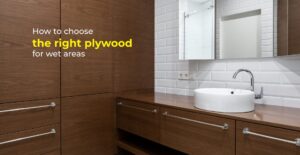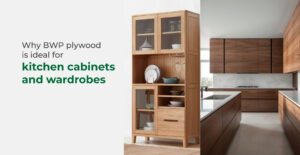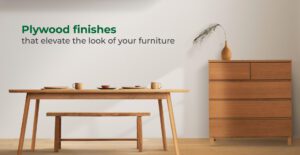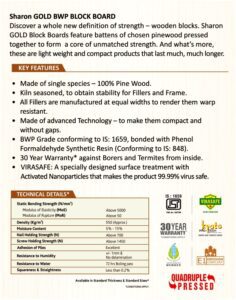

When it comes to choosing materials for construction or furniture making, plywood is often the top choice because of its strength, versatility, and aesthetic appeal. However, selecting the right plywood requires careful attention to several factors beyond just cost. A wrong decision can compromise the quality, durability, and safety of your project.
Table of contents
One common mistake buyers make is neglecting to check the plywood grade. Plywood comes in various grades, each designed for specific purposes, such as decorative finishes or structural applications. Using a lower-grade plywood for high-quality interior work can lead to poor appearance and reduced durability. Always ensure the plywood grade matches your project requirements, whether for aesthetic appeal or structural strength. Understanding plywood grades helps you make informed choices and achieve better results while justifying the investment.
Thickness is a critical factor when purchasing plywood. Using plywood that is too thin for a load-bearing structure can lead to bending, sagging, or even structural failure over time. On the other hand, using unnecessarily thick plywood where it is not needed adds to the cost without any real benefit.
Understand the intended use—whether it is for shelving, flooring, wall paneling, or furniture—and select the thickness that provides the best combination of strength, flexibility, and cost-effectiveness. Consulting a professional or following recommended standards for different applications can make the selection process easier and more accurate.
In areas prone to high temperatures or fire hazards, opting for regular plywood without considering fire resistance can be a dangerous oversight. Fire-retardant plywood is specially treated to slow down the spread of flames and smoke during a fire incident.
If you are buying plywood for commercial spaces, kitchens, or public buildings, prioritizing fire resistance can add an essential layer of safety to your project. It not only protects your property but also enhances compliance with safety regulations, which is critical for commercial or public infrastructure.
Another common mistake is neglecting the formaldehyde emission standards of plywood. Formaldehyde is a chemical used in the adhesives for bonding plywood layers, and excessive emissions can cause serious health concerns, including respiratory issues.
Always look for plywood that complies with E0 or E1 emission standards, which guarantee minimal release of harmful gases. Choosing low-emission plywood ensures a healthier indoor environment, especially important for homes, offices, and schools. It also shows a commitment to sustainable and responsible building practices.
Wood-based products can be easily damaged by termites and borers if they aren’t treated properly. Ignoring this can lead to high maintenance costs and damage to the structure over time.
Many well-known plywood brands offer termite and borer-resistant options to help prevent these issues. Always check if the plywood has been treated with anti-termite chemicals and has certifications to prove its resistance. This precaution can significantly extend the life of your furniture and structures. Remember, preventive care is always less expensive and less stressful than repairs or replacements.
Impulse buying or relying solely on the seller’s recommendation without personal research can result in disappointment. Every plywood variant has unique features, benefits, and limitations.
Take time to research different types of plywood, understand brand reputations, compare prices, and read customer reviews before making a decision. Being well-informed helps you pick the most suitable plywood based on your project needs and budget. Visiting showrooms, checking samples, and seeking expert advice can further boost your confidence in your final choice.
While everyone wants to save money, focusing only on price when buying plywood can be a costly mistake in the long run. Low-cost plywood may lack critical features such as moisture resistance, termite protection, or structural stability.
Instead of selecting the cheapest option, prioritize plywood that meets the technical demands of your project. Balancing cost with quality ensures that you get durable, safe, and visually appealing results that are worth the investment. Long-term performance should always outweigh short-term savings when it comes to building materials.
Buying plywood is not just about choosing a sheet that looks good; it is about finding the right material that matches the functional, aesthetic, and environmental demands of your project.
Here are some smart buying tips:
For a deeper understanding, check out Factors to Consider While Choosing Plywood.
With the right approach, you can ensure that the plywood you buy adds long-term value to your constructions and designs. A well-researched decision today can save you from unnecessary expenses and hassles tomorrow.
For those who value quality, durability, and performance, SharonPly offers a trusted range of plywood solutions that meet the highest standards of excellence. Choose wisely, and let your projects stand strong and beautiful for years to come.










Users understand that SHARONPLY is committed to protecting the User’s privacy and shall take all efforts to protect any personal data provided to the Website by reasonable security safeguards against such risks as loss or unauthorised use, destruction, modification or disclosure of data, However, in case of any lapse, SHARONPLY shall not be held responsible for any effect or consequences thereof. The Website uses cookies to track usage of the path of the User. Since most web browsers automatically accept cookies, User can edit User’s browser options to block them if User does not want the Website to use cookies to track usage of the path of the User.
SHARONPLY undertakes not to disclose, except as otherwise provided, the personal information provided by the User to any person, unless such action is necessary to: –
By filling up any form on the Website User automatically grants SHARONPLY a royalty-free, perpetual, irrevocable non-exclusive license to use, reproduce, publish, edit, distribute, and publicly display the information given in the form and to sublicense such rights.
Any queries regarding the SHARONPLY’s privacy policy, may be sent to admin@sharonply.com.

